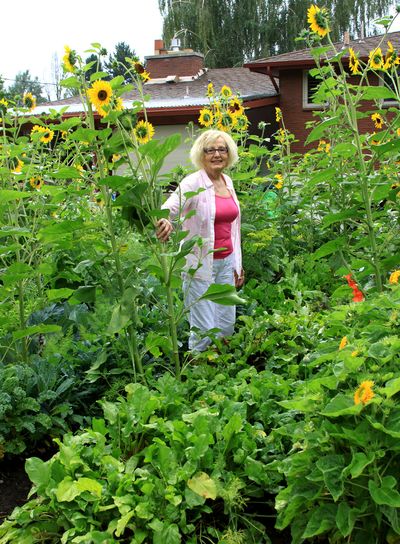In the Garden: ‘Lasagna gardening’ yields big harvest

Sometimes it really pays to think outside the box. Last year, Mary Lee Gaston did just that and it has completely changed the way she grows her vegetable garden.
A friend of hers had been telling her about the “lasagna gardening” method, which involves layering organic materials on top of the ground to improve one’s soil and create a rich environment for plants to grow in.
Gaston, who lives in northwest Spokane, didn’t want to build raised beds and was anxious to cut down on weeding, which had been a frustrating problem in previous years. After hearing she’d spend less time weeding by doing lasagna gardening, she knew it was worth a try.
“I felt like I was cheating Mother Nature by not using the soil, but the results were phenomenal,” Gaston said.
She had one of her more productive gardens ever and is using the same method this year.
Here’s what she did:
“I created three mounds last year that were 3 feet wide and 40 feet long,” she explained. “I used newspapers as the first layer because they rot real fast and have soy-based ink so they’re safe to use. Next, I put down a layer of thin cardboard so it won’t take long to rot. After that, I added dry pine needles and leaves. The top layer was composted chicken manure.”
She grows everything organically, using leaves from neighbors’ trees – making sure they haven’t been treated with chemicals – organic chicken manure from Whitney Farms and homemade compost.
Last year, Gaston grew potatoes, onions, lettuce and kale in the new mounds and was astounded by how well everything grew.
She was impressed particularly by how loose the soil was; she could just reach into the mix and pull out potatoes with her hands. In addition, she appreciated the lack of weeding she had to do.
“I would occasionally see a weed but that was because I hadn’t put enough newspaper down,” she said. “I’d pull the weed, put down more newspaper and throw on some more compost.”
This year, Gaston has created 10 mounds in her garden using the layering method. She’s growing a wide variety of crops in the mounds – green beans, carrots, cardoon, broccoli, cabbage, Italian lettuces, tomatoes, onions, potatoes, Swiss chard, beets, amaranth, kale, peppers and eggplant – and everything is growing beautifully.
She’s a little frustrated, though. Early in the season, she wasn’t able to get some additional organic compost so went with a load of composted steer manure instead.
“The manure wasn’t composted well enough so it leached nitrogen, and I had to track down a large amount of chicken manure to take care of that,” she explained. “And I’ve had a ton of weeds from the seeds in the steer manure. I won’t make that mistake again.”
But overall, Gaston is completely sold on the lasagna gardening method.
“Last year, I got twice as much produce from the garden as I have in past years, and there were 95 percent fewer weeds compared to what I used to deal with,” she said. “And it was phenomenal to have such soft medium that I was able to do things with my hands instead of needing tools. It was absolutely perfect.”